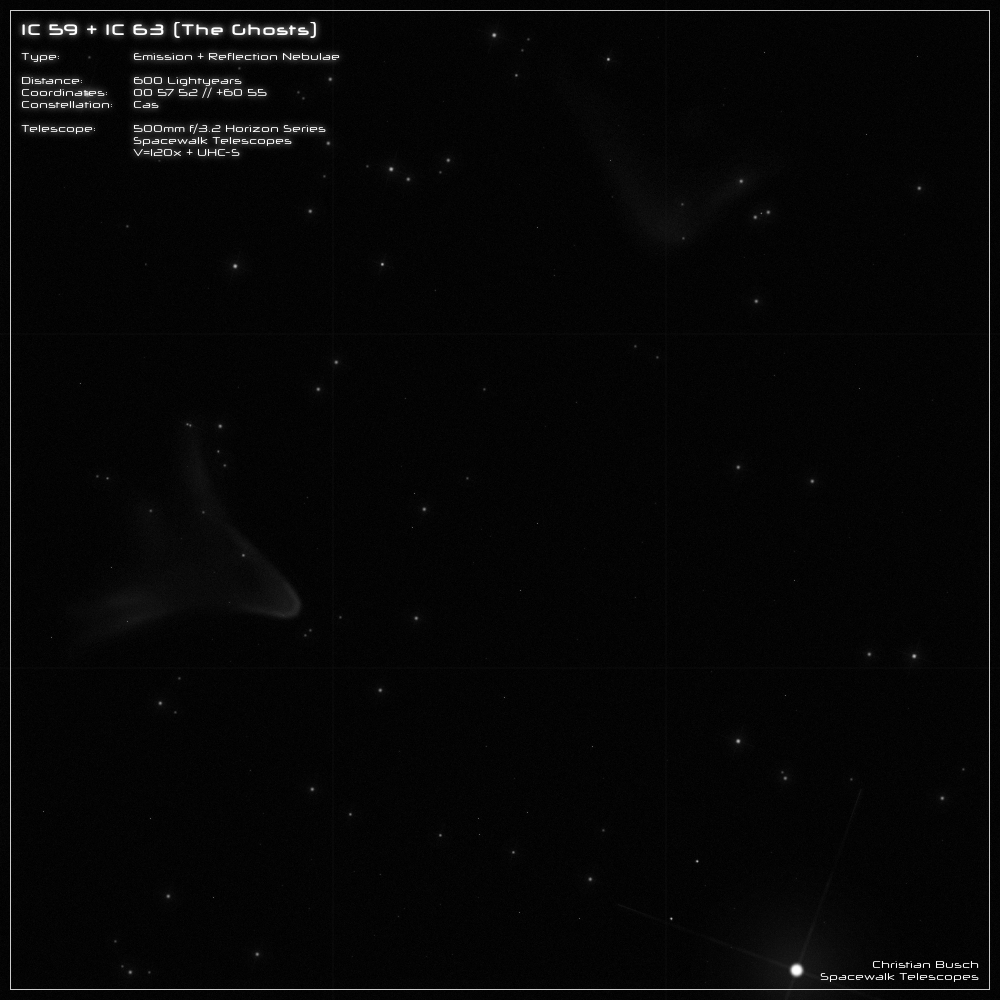IC 59/63 - The two little ghosts
In the constellation Cassiopeia you can find beside the "Bubble- Nebula" or the "Pacman- Nebula" countless other great objects, but there is one
in particular that I like. It is actually two objects, namely the gas nebulae "IC 59" and "IC 63", which always remind me of two little ghosts
because of their shape.
The two nebulae are located only 25' away from the 2.2mag bright star "Gamma Cas", which is not only there by chance, but actually causes the
nebulae to glow. So without star no nebulae.
Gamma Cas itself is also quite an interesting star - one of the brightest stars in the northern sky without a real name. In Sky Safari, the name
"Navi" is found, which I considered quite unusual. But it turns out that it is "Ivan" spelled backwards and corresponds to the middle part of the
name of the astronaut "Virgil Ivan Grissom", who was part of the "Mercury program" in the 1960s and is probably responsible for this naming.
Gamma Cas belongs to the group of blue giant stars with a spectral type of B0.5 and a surface temperature of about 30,000 Kelvin. At a distance
of 550 light-years its luminosity is calculated to 60,000 suns. Due to its high rotational velocity the star is flattened. Furthermore it belongs to the
group of variable stars and had a maximum brightness of 1.6mag at the end of the 1930s. At that time it was the brightest star in the constellation
Cassiopeia. Today it is not any more. And as if that wasn't enough, "Gamma Cas" is also a double star, which should be very difficult to separate.
Because only 2.2" (arcseconds) beside the 2mag bright main star you find a 11mag faint companion. This is a brightness difference of 9 magnitudes,
so the separation of "Gamma Cas" should be a big challenge.
The two nebulae IC59/63 have both an emission and a reflection component. This is also well visible on color images by the reddish and blue gas
masses. The true distance of the two nebulae to Gamma Cas is about 3-4 light years, with IC 59 being the more distant of the two. Deeply exposed
images in H/alpha light show that IC59 and IC63 belong to a much larger nebular complex with a diameter of 2° and 10 light-years, respectively.
It is a bubble of hot, ionized hydrogen gas often found around O and B stars and is called the "Strömgren sphere".
----------------------------------------------------------------------------------------------------------------------------------------------
IC59/63 can be found quite fast, you only have to point the telescope to the center star of the sky W's. And that's where the problems start ;)
On the one hand the star appears so bright in the 20" f/3 that you almost burn a hole in your retina and the dark adaptation says goodbye directly.
And on top of that both nebulae are quite faint (that's why the IC numbers). Don't let the drawing fool you - but somehow I had to bring the faint
nebulae onto the monitor with high contrast.
If you managed to position "Gamma Cas" outside the field of view and the retina recovered from the first shock, the head of the brighter ghost
(IC 63) can be seen quite well at 120x. If you magnify a bit higher (200x), you can even see the heated shock front as a slightly brightened edge
with indirect vision. The other ghost (IC 59) is a bit more shy and not so easy to see - so you have to look even closer to see it as a pale glow
with indirect vision.

